Using County Health Rankings and Roadmaps on MTCF
County Health Rankings and Roadmaps
The County Health Rankings and Roadmaps (CHR&R) is a program run by the University of Wisconsin Population Health Institute. The program uses a large number of datasets from state and national sources that provide targeted measures of health. Those measures are then combined within categories as shown in the figure below (source: CHR&R Methods Website).
MTCF users can access the 2022 scores for the top-level measures of health (Health Outcomes and Health Factors) and their immediate sub-categories (shown in the figure below – two sub-categories make up Health Outcomes and four make up Heath Factors). Each county is assigned a rank from 1 to 83, with 1 indicating the highest ranking (least concern) and 83 the lowest (most concern). Users can also access a simplified score that groups counties into five groups (ranks 1-17, 18-33, 34-50, 50-66, and 67-83).
The county-level CHR&R equity variables are available on MTCF: Health Outcomes, Health Factors, Length of Life, Quality of Life, Health Behaviors, Clinical Care, Social and Economic Factors, and Physical Environment. More information on the CHR&R, and details on the sources it draws from, can be found on the organization’s website: https://www.countyhealthrankings.org/.
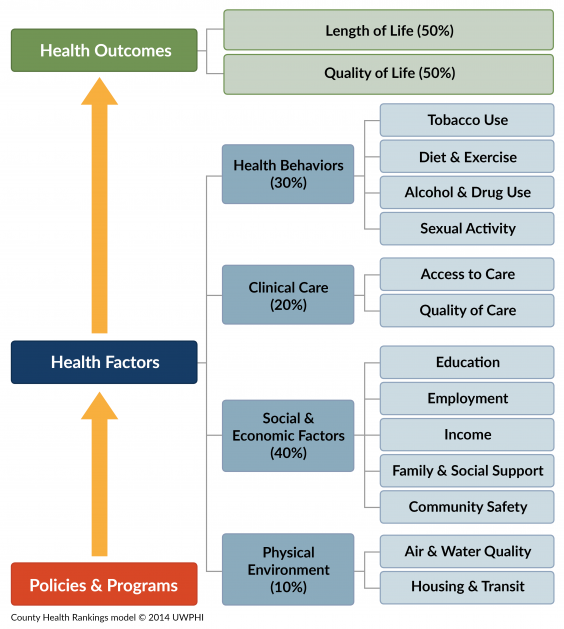
Example Use Cases
The primary advantages county-level equity measures have over tract-level measures are that they make it easier to visualize statewide trends and that there is more data available at the county level. For example, due to the higher density of Census tracts in urban areas and the sheer number of tracts in Michigan (more than 3,000 as of 2021) state-level visualizations of tract-level data can be difficult to parse and draw conclusions from visually.
In this section we will demonstrate how CHR&R can be used to answer questions about the equitability of crashes using the MTCF website. We will be addressing two research topics:
- Examine how rates of pedestrian-involved crashes correspond to the CHR&R areas of high concern
- Compare the distribution of crashes involving speeding to crashes overall across counties with different CHR&R scores
The presence of rates in the first topic requires that we use county-level equity measures because exposure metrics, like VMT or licensed drivers, will only be available for at the tract level. The second topic can also be addressed using tract-level metrics, but we choose to use a county-level metric for demonstration.
For these example use cases, we will be using the “Health Factors” top-level score from CHR&R.
1. Examine how rates of pedestrian-involved crashes correspond to the CHR&R areas of high concern
Step 1: Get Pedestrian-involved Crash Rates
From the MTCF Data Query Tool, click on “Time Frame” and select 2023. With 2023 selected, click on “View County Map” from the list of Output options on the right.
On the County Map page, use the dropdown menu for “Rate” to select “VMT (Vehicle Miles Traveled)” and the dropdown for “Select (Optional) display variable” to select “Crash: Pedestrian”. The map below will automatically update with each of these changes.
Once these options are selected, the map will show the counties colored according to their pedestrian-involved crash rates. Darker shades indicate higher rates and lighter shades indicate lower rates.
Note that Wayne, Ingham, Kent, St. Joseph, and Kalamazoo counties have the highest rates (in that order) and seven counties have pedestrian-involved crash rates of zero per million VMT, indicating 0 pedestrian-involved crashes in that county.
At the end of this step you should see the following:
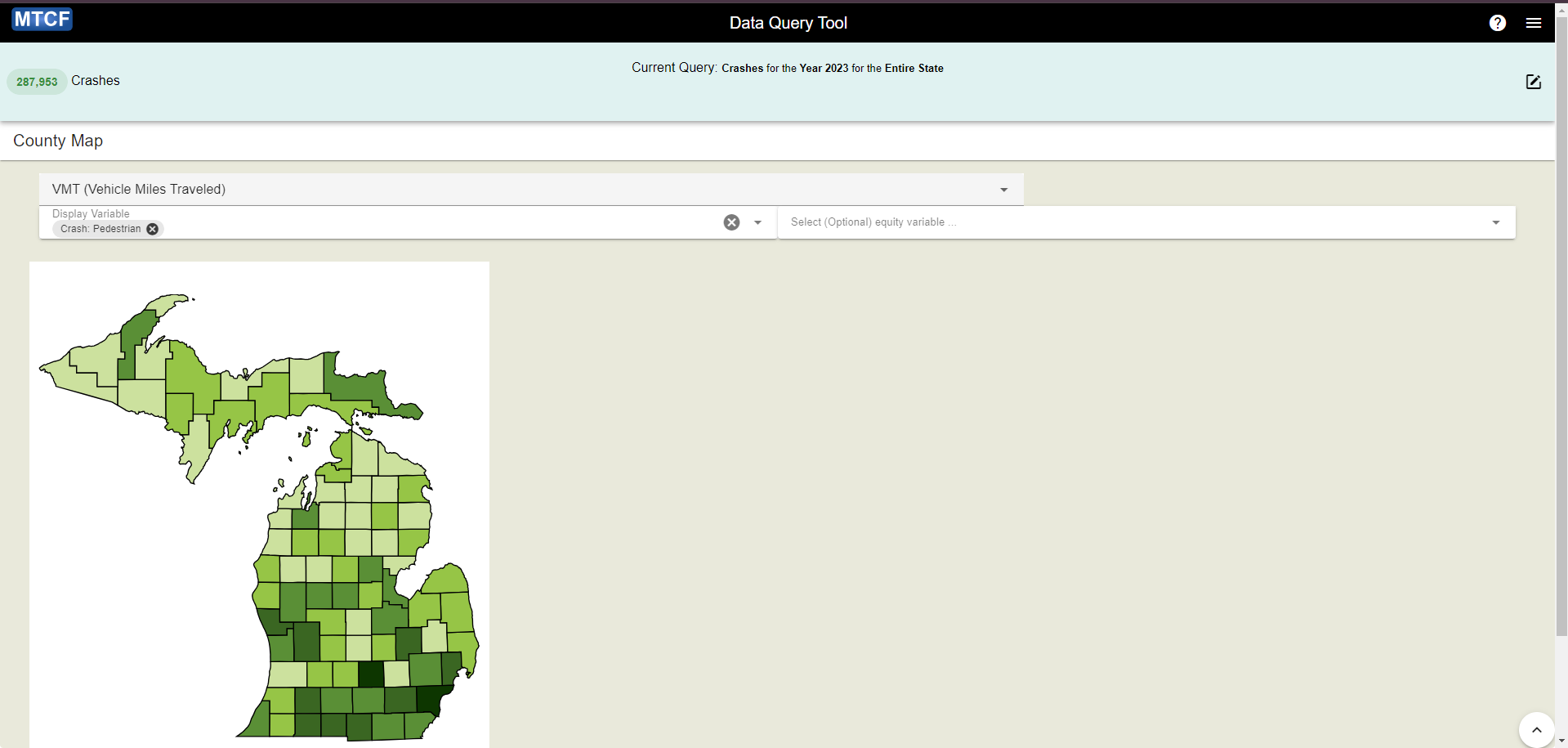
Step 2: Add Equity Overlay
Now click on the “Select (optional) equity variable” dropdown and select “Equity: Health Factors (2022+)”. This will add an additional interface that allows you to select which levels of concern should be marked for the selected equity measure.
Using that interface, select the “Most Concern” category (meaning the 20% most inequitable according to the CHR&R Health Factors score). This places yellow circles on the counties that are of most concern.
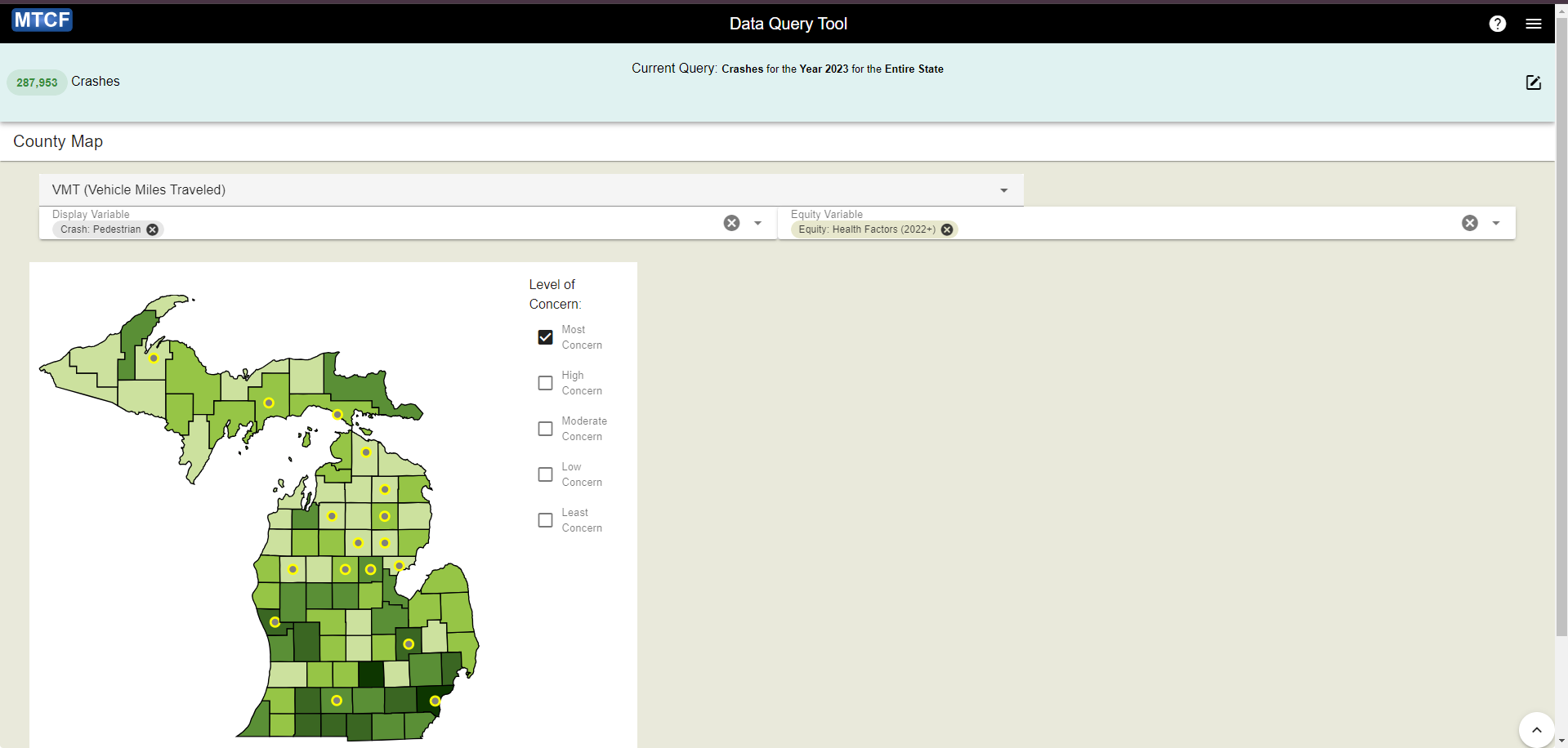
Note that there is some overlap between counties with high rates of pedestrian crashes and counties that are marked as “Most Concern” by the CHR&R Health Factors score but many counties with low pedestrian crashes are also of concern. Of the five counties with the highest rates of pedestrian-involved crashes per million VMT, only Wayne county is marked as also having the most concern for Health Factors.
If we increase the marking to include “High Concern” counties (as shown in the screenshot below) it appears that a larger proportion of the high crash rate counties are captured, though Ingham and Kent are not. This suggests that the CHR&R Health Factors score does not fully capture the factors that increase the risk of pedestrian crashes.
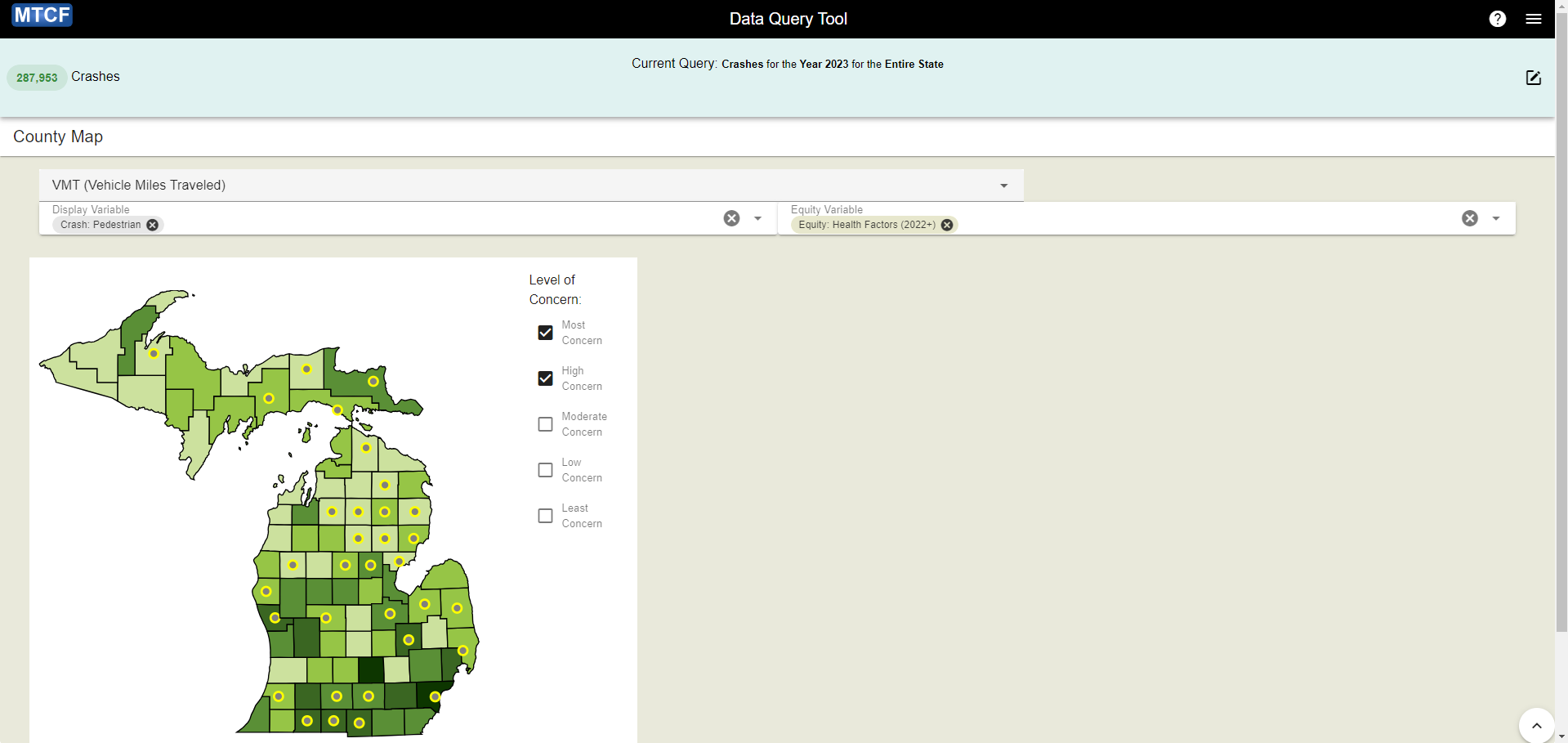
2. Compare the distribution of crashes involving speeding to crashes overall across counties with different Michigan CRI scores
Step 1: Establish Baseline
From the MTCF Data Query Tool, click on “Time Frame” and select 2023. With 2023 selected, click on “View Table”.
On the Table page, click on the dropdown menu for “Select Row(s)” and select “Equity: Health Factors (2022+)”. Then click “Apply”. This table is our baseline for the occurrence of crashes in counties in each equity category.
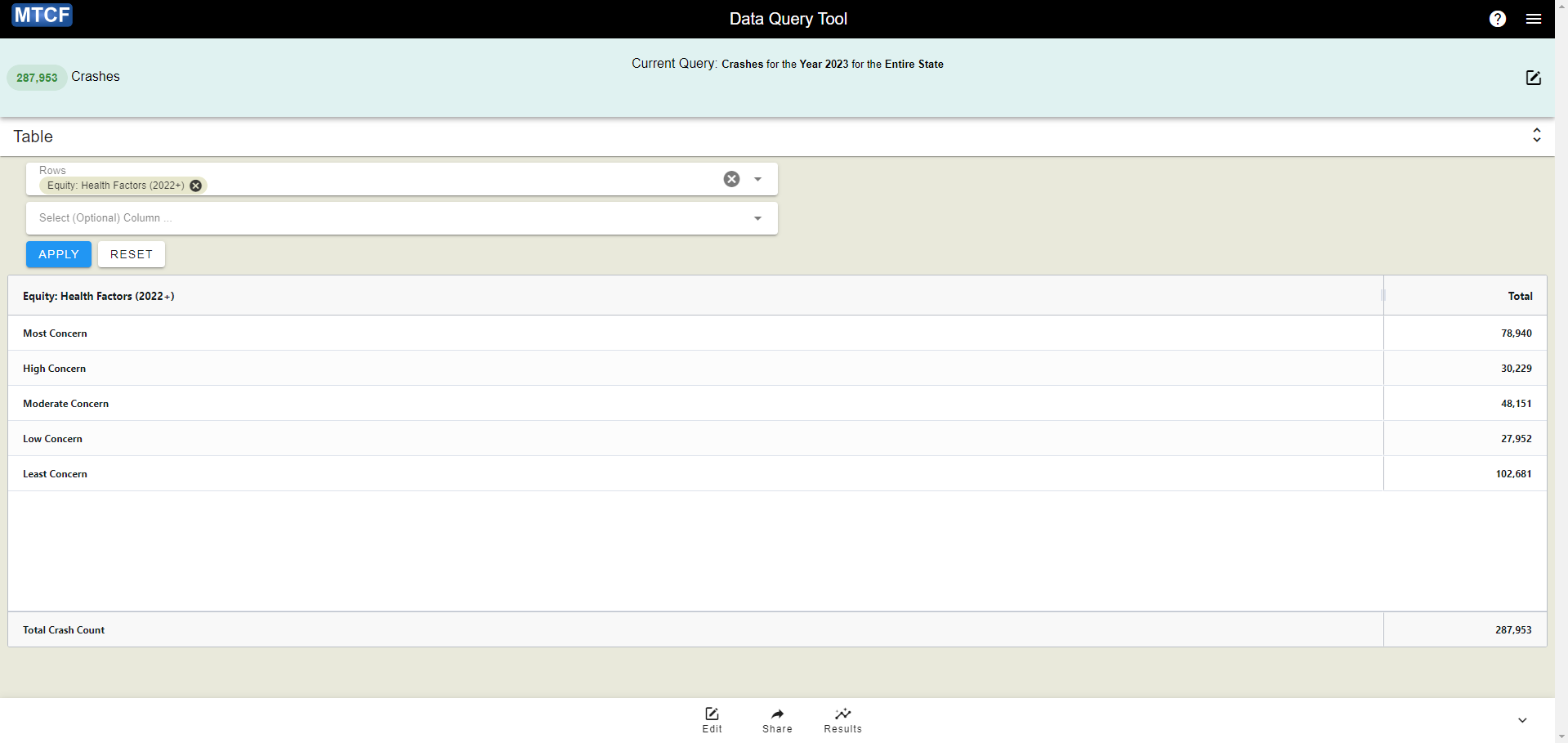
Step 2: Configure Speeding Crash Query
Open a new instance of the Data Query Tool (or select “Edit Query” from the end of the previous step if you have saved the output) and open the “Filters” selection.
In order to identify crashes involving speeding, we need to apply two filters:
- Hazardous Action = “Speed Too Fast”
- Traffic Unit Type = “Motor Vehicle”
Note that these are both unit-level filters (the blue section in the filter dropdown). As such, we will identify crashes that have one or more motor vehicles whose drivers were coded as “Speed Too Fast” by the responding police officer at the time of the crash.
If these filters are correctly applied, the Data Query Tool will show “21,357 Crashes” and the current query will be: “Crashes for the Year 2023 for the Entire State filtered by Hazardous Action (Speed Too Fast) and Traffic Unit Type (Motor Vehicle)”.
Step 3: Create Speeding Table
After applying the filters in Step 2, create a table using the filtered dataset following the process in Step 1.
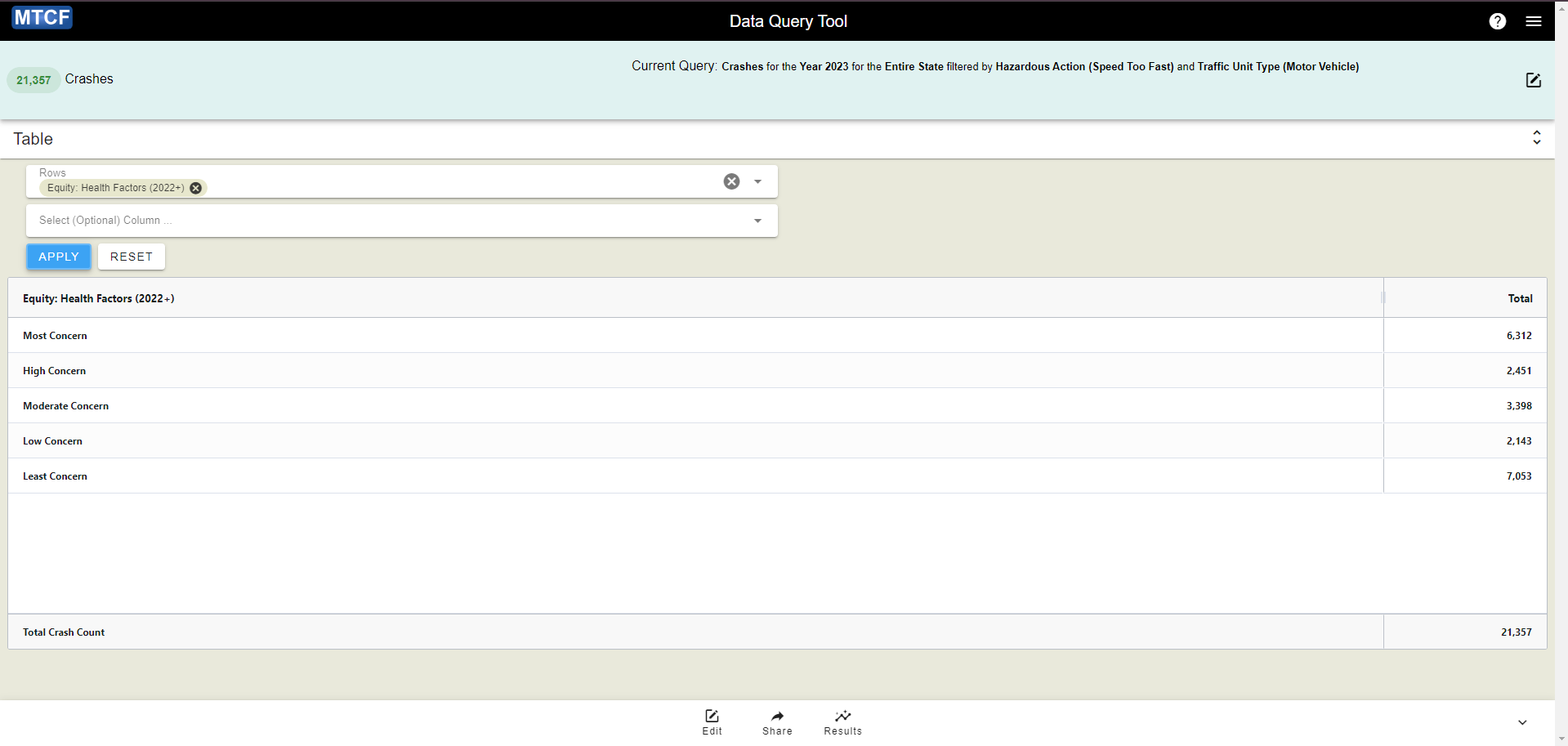
Step 4: Compare Behavior
Once you have both tables, you can compare the results as in the table below:
| Level of Concern | All Crashes | Crashes Involving Speeding |
|---|---|---|
| Most Concern | 27.4% | 29.6% |
| High Concern | 10.5% | 11.5% |
| Moderate Concern | 16.7% | 15.9% |
| Low Concern | 9.7% | 10.0% |
| Least Concern | 35.7% | 33.0% |
Based on these data, it does not seem that crashes involving speeding are more prevalent in areas of greater inequity (as defined by the CHR&R Health Factors score).